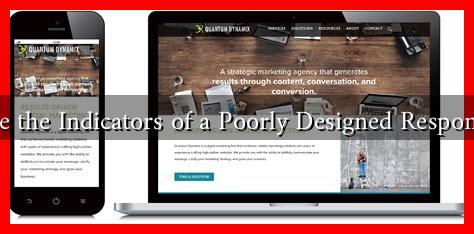-
Table of Contents
What Are the Indicators of a Poorly Designed Responsive Site
In today’s digital landscape, having a responsive website is no longer optional; it is a necessity. A responsive site adapts seamlessly to various screen sizes, ensuring an optimal user experience across devices. However, not all responsive designs are created equal. Some may appear functional at first glance but can harbor significant flaws that hinder usability and engagement. This article explores the key indicators of a poorly designed responsive site, helping you identify and rectify these issues for a better user experience.
1. Slow Loading Times
One of the most critical indicators of a poorly designed responsive site is slow loading times. According to Google, 53% of mobile users abandon sites that take longer than three seconds to load. A sluggish site can lead to high bounce rates and lost conversions.
- Large Images: Unoptimized images can significantly slow down loading times. Ensure that images are compressed and appropriately sized for different devices.
- Excessive JavaScript: Overuse of JavaScript can lead to performance issues. Minimize scripts and use asynchronous loading where possible.
- Too Many HTTP Requests: Each element on a page requires an HTTP request. Reduce the number of elements to improve loading speed.
2. Inconsistent Layouts
A responsive site should maintain a consistent layout across devices. If users experience drastic changes in layout, it can lead to confusion and frustration.
- Text Overlap: On smaller screens, text should not overlap with images or other elements. This can make content unreadable.
- Navigation Issues: If navigation menus change drastically between devices, users may struggle to find what they need.
- Content Clutter: A poorly designed responsive site may cram too much information onto smaller screens, overwhelming users.
3. Touchscreen Usability Problems
With the rise of mobile devices, touchscreen usability has become paramount. A responsive site that does not account for touch interactions can frustrate users.
- Small Clickable Areas: Links and buttons should be large enough to tap easily. If they are too small, users may accidentally click the wrong element.
- Hover Effects: Relying on hover effects for navigation can be problematic on touch devices, as there is no hover state.
- Inaccessible Forms: Forms should be easy to fill out on mobile devices. If fields are too small or poorly spaced, users may abandon the process.
4. Poor Typography
Typography plays a crucial role in user experience. A responsive site with poor typography can lead to readability issues, especially on smaller screens.
- Inconsistent Font Sizes: Font sizes should be scalable and consistent across devices. If text is too small, users may struggle to read it.
- Poor Contrast: Text should have sufficient contrast against its background. Low contrast can make reading difficult, especially in bright environments.
- Line Length and Spacing: Long lines of text can be hard to read on mobile devices. Ensure that line length and spacing are optimized for readability.
5. Lack of Testing Across Devices
A responsive site must be tested across various devices and browsers to ensure compatibility. A lack of testing can lead to unforeseen issues that affect user experience.
- Browser Compatibility: Ensure that your site functions correctly on all major browsers, including Chrome, Firefox, Safari, and Edge.
- Device Testing: Test your site on different devices, including smartphones, tablets, and desktops, to identify layout and functionality issues.
- Screen Orientation: Check how your site performs in both portrait and landscape orientations, as this can affect usability.
Conclusion
In conclusion, a poorly designed responsive site can significantly impact user experience, leading to high bounce rates and lost conversions. By paying attention to indicators such as slow loading times, inconsistent layouts, touchscreen usability problems, poor typography, and a lack of testing, you can identify and rectify issues that may be hindering your site’s performance. Investing time and resources into creating a well-designed responsive site will not only enhance user satisfaction but also improve your site’s overall effectiveness. For further insights on responsive design best practices, consider visiting Smashing Magazine.

